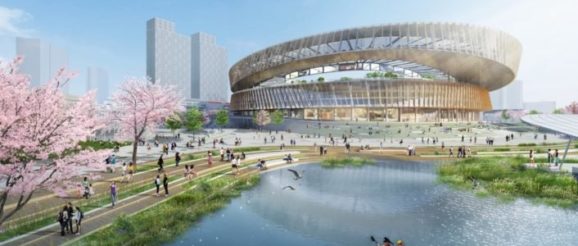Sasaki to transform Shanghai’s Hongkou Stadium with a High Line-esque park | Inhabitat – Green Design, Innovation, Architecture, Green Building

International disciplinary planning and design firm Sasaki has unveiled designs to transform China’s first professional soccer stadium into a sustainably minded mixed-use hub focused on health and wellness. Designed to stitch the Shanghai Hongkou Stadium back into the urban fabric, the proposal will reactivate the stadium as a destination even on non-game days while improving the expanded building’s energy efficiency. Key to the design intervention will be the addition of the Midline, an elevated park built along a light rail corridor, which will provide a green link between Hongkou’s university district in the north and the cultural and commercial districts to the south.
Located on a major north-south green corridor, Shanghai’s Hongkou Stadium is accessible via public transit yet suffers from lack of interest on non-game days and lack of connection to its urban surroundings. To reposition the stadium as the heart of a new mixed-use health and wellness hub, Sasaki plans to not only extend the lush landscape of the adjacent Luxun Park to the stadium grounds, but also add the elevated Midline, a recreational spine beneath the light rail tracks that provides pedestrian and bicycle access from the north and south to the stadium. In addition, new shops and restaurants on the street level will activate the stadium’s main plaza and podium.
Moreover, the stadium, which was built in the 1990s, will be expanded to a total of 50,000 seats and nine levels to accommodate new programming such as a soccer museum, VIP clubs, community recreation facilities and a cantilevered restaurant with 360-degree views of the field. Rooftop gardens and outdoor concourses will be publicly accessible from the adjacent Luxun Park to attract the community year-round.
“By positioning the stadium as a community asset, its renovation reaches far beyond its original function,” reads Sasaki’s press release. “Many stadiums serve the single purpose of hosting sporting events, resulting in an empty building during non-game days and in the off-season. Hongkou Stadium reimagines the arena as a multi-functional complex that fulfills the demands of large events while also serving as a unique public space for all citizens.” The renovated stadium will also be optimized for energy efficiency and tap into passive ventilation strategies. Rainwater runoff will be harvested in underground cisterns and reused as irrigation. The stadium’s new smart glass facade can be digitally adjusted to minimize unwanted solar heat gain and used as a digital screen to broadcast events.
